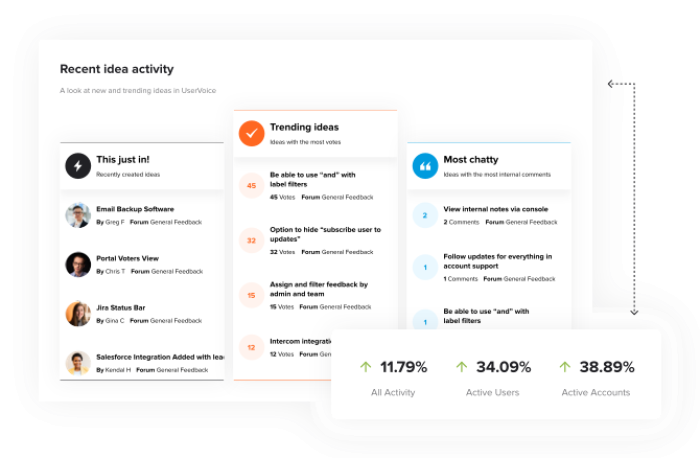User feedback is the secret to building products your users will love. It reveals what’s working, what’s not, and where to focus your efforts. But gathering that feedback isn’t always easy.
In-app feedback tools make it easy for users to share their thoughts right within your app—no email reminders, no complicated forms. Whether it’s through visual feedback widgets or quick in-app survey tools, they let you gather actionable insights into exactly when and where users are engaging with your product.
But with so many in-app feedback tools out there, how do you choose?
We’ve done the work for you: we reviewed dozens of the best customer feedback tools, looking at features, success stories, user reviews, and ratings to bring you the top choices. These tools make it easier to gather customer feedback that drives real results.
In-app feedback is the practice of getting contextual feedback from your users inside your product so you can determine what works and what doesn’t.
In-app feedback tools can easily help you meet customers where they are, enabling you to collect relevant feedback and get actionable insights.
To help you find the right tool for your business, we're showcasing the top tools in the market, including Chameleon, Pendo, Appcues, WalkMe, Userflow, Userpilot, Intercom, and SatisMeter by Productboard.
When choosing the right in-app feedback solution, make sure that it has a powerful and intuitive interface, along with ample features and capabilities that work with your tech stack, continuous feedback options that can lead to more growth opportunities, and high-quality customer support.
What is an in-app feedback tool?
An in-app feedback tool is a feature within an application that allows users to provide feedback directly without leaving the app. This can include reporting bugs, suggesting new features, or sharing general thoughts about the user experience.
In-app customer feedback tools often appear as feedback widgets, in-app surveys, or rating prompts, making it convenient for users to communicate their insights in real time.
Types of customer feedback
Customer feedback comes in many forms. Here’s a quick breakdown:
Usability feedback: This focuses on how easy (or difficult) your product is to use. Users might highlight confusing navigation, clunky workflows, or areas where they get stuck. Usability feedback helps you refine the user experience and create a smoother journey.
Feature requests: Users love sharing ideas for what your product could do. Feature requests give you a window into what your audience values most and what enhancements could boost engagement.
Bug reports: Nobody likes running into glitches. Bug reports point out errors or technical issues that disrupt the user experience, helping your team quickly address and resolve them.
Satisfaction ratings: Think NPS surveys or star ratings. These measure how happy your users are with your product, offering a high-level view of overall satisfaction and areas for improvement.
Now that we know what feedback looks like, let’s check out the in-app feedback tools that make collecting it feel effortless—and, dare we say, kind of fun.
8 Top in-app feedback tools
1. Chameleon: Best for building the ideal customer experience
Chameleon is a product adoption platform for better user onboarding and in-app feedback loops with an intuitive, sleek interface. This enables you to quickly create in-app surveys and feedback opportunities to get the answers you need about your product.
Chameleon’s top in-app feedback features include Microsurveys, which enable you to request feedback from app users at specific points in the product experience. Microsurveys can consist of a single question or multiple questions, depending on your needs. You can easily set up and run Net Promoter Score® (NPS) surveys, customer satisfaction (CSAT) surveys, Customer Effort Score (CES) surveys, or ask directly for users' opinions.
Key features:
Product tours: Interactive guides that walk users through key features and workflows within the application
NPS & Microsurveys: In-app surveys that collect user feedback and insights directly within the product interface
Tooltips: Contextual help elements provide information about specific features or UI elements when users interact with them
Banners: Non-intrusive in-app messages that can be embedded within the UI to deliver updates or announcements.
Embedded cards: Content blocks that can be embedded within the product to promote content and events, or gather feedback
HelpBar: A universal search feature that allows users to quickly find and access help content, FAQs, and resources without leaving the application
Integrations: Key integrations include Google Analytics, Mixpanel, Salesforce, HubSpot, Intercom, Slack, Figma, Airtable, and Navattic
Pricing
Chameleon offers a Startup plan for small companies starting at $279 per month, and a Growth plan for growing businesses starting at $599 per month.
Not sure where you’ll fit in? The Chameleon pricing page has a calculator to help you predict your spending based on monthly user growth.
Let's hear what product leaders at Heap, ActiveCampaign, and Braze have to say:
Why wing it? Start owning your user journey with Chameleon
Get started for free with Chameleon and harness the power of product tours, tooltips, checklists, surveys, and more
2. UserVoice: Great for collecting feature requests

UserVoice is all about helping you gather and prioritize user feedback with ease. Its feedback widgets let users share suggestions, report bugs, or vote on ideas directly in your app. It’s especially great for managing feature requests, collecting feedback, spotting trends, and aligning your product roadmap with what users really want.
Key features
Feedback Portal: A branded, customizable space where customers can submit, vote on, and discuss product ideas and feature requests
Contributor Sidebar: Enables internal teams to capture customer feedback from any web-based application
Customizable Organizational Tools: Helps map feedback data to specific product suites, teams, and customer segments
Automated Status Updates: Notifies users and team members as ideas progress through different stages
AI-powered Merge Matches: Automatically detects and consolidates similar ideas to reduce duplication
Multi-channel Feedback Collection: Gathers input from web widgets, mobile apps, email, and social media
Voting System: Enables users to rank and prioritize feature requests
Pricing
Growth: $899 per month
Team: $1,199 per month
Strategic: $1,349 per month
Enterprise: Custom quote
3. Intercom: Best for customer support

Intercom is a customer communications platform that unifies every aspect of the customer journey, from conversion to engagement to support. In-product messaging solutions enable you to reach customers while they’re using your product and include features such as chatbots, banners, surveys, and more.
Key features
Live Chat: Highly customizable live chat functionality with integration capabilities
Fin AI Agent: An AI-powered chatbot with high resolution rates that can handle frontline support
Ticketing System: Manages and tracks customer issues efficiently
Conversation Topics: Helps analyze common themes in customer interactions
Customizable Reports: Offers real-time performance data and actionable insights
Pricing
Essentials: $29 per seat per month
Advanced: $85 per seat per month
Expert: $132 per seat per month
4. Zendesk: Customer support tool

Zendesk is a go-to for customer support, but it also helps you collect in-app feedback. Its feedback widgets and in-app surveys let users share their thoughts without leaving your app. Plus, Zendesk automatically gathers helpful context, like device details and app versions.
Key features
Ticketing System: Collects and manages customer requests from multiple sources in a centralized dashboard
Self-Service Knowledge Base: Provides a repository of articles, FAQs, and guides for customers to find answers independently
Mobile Apps: Offers mobile applications for agents to manage support on-the-go
AI-Powered Features: Includes chatbots, automated triage, and virtual agents to enhance customer support efficiency
Pricing
Zendesk only offers annual plans:
Suite Team: $55 per agent per month
Suite Growth: $89 per agent per month
Suite Professional: $115 per agent per month
Suite Enterprise: Custom quote
5. Hotjar by Contentsquare: Ideal for heatmaps

Hotjar specializes in understanding user behavior through heatmaps, session recordings, feedback buttons, surveys, and user tests and interviews. It’s designed to show you how users navigate your site, where they click, and where they drop off. While it’s great for web app insights, it’s not effective for mobile app feedback collection.
Key features
Heatmaps: Visualize user behavior on websites, showing the most and least active areas
Session Recordings: Capture real-time user interactions, including mouse movements, clicks, and scrolls
Flexible Screenshot Retaker: Analyze dynamic content like drop-downs and pop-ups in heatmaps
AI-Powered Features: Automatically create surveys and generate summary reports
Funnels and Trends: Measure conversion rates and explore metrics to uncover user behavior trends.
Pricing
Free
Growth: $49 per month
Pro and Enterprise plans: Custom quote
6. Qualaroo: Known for pop-up surveys

Qualaroo is best known for its Nudges—lightweight pop-up surveys that appear at the right time and place. While it works for web and mobile apps, its strength is gathering targeted feedback from specific user segments. Since it was acquired by ProProfs in 2019, Qualaroo has integrated with other tools like knowledge bases and chat support.
Key features
Multi-channel support: Deploy surveys across websites, mobile apps, emails, and digital products
Pre-built survey templates: Access professionally designed templates for various survey types, including NPS and CSAT
Skip logic and branching: Create dynamic surveys that adapt based on user responses
AI-powered sentiment analysis: Automatically categorize and analyze feedback emotions
Custom coding flexibility: Modify survey design and functionality using custom CSS and JavaScript
Pricing
Free
Business: $79.99 per month
7. Survicate: Good for surveys

Survicate is a versatile online customer feedback tool that gathers insights through in-app surveys, feedback widgets, and email surveys. Its user-friendly interface makes it easy to create and launch surveys tailored to your audience. With integrations for tools like Intercom and HubSpot, you can streamline feedback collection and analysis.
Key features
AI-powered survey creation and analysis: Generate surveys quickly and analyze results efficiently using AI technology
Advanced targeting options: Show surveys to specific audiences based on behavior, demographics, or custom properties
Survey logic and branching: Create dynamic surveys that adapt based on user responses
Real-time analytics and reporting: Access reporting tools and pre-built dashboards for instant insights
Feedback Hub: Centralize feedback from multiple sources in one place
Pricing
Free
Good: $99 per month
Better: $149 per month
Best: $249 per month
Better Than The Rest: Custom quote
8. Wootric: Great for spotting trends

Wootric, part of the InMoment platform, focuses on customer feedback metrics like NPS, CSAT, and CES. It’s built to collect detailed feedback through in-app surveys, email, and SMS, helping you track customer sentiment over time. With AI-driven insights and analytics, Wootric makes it easy to spot trends and prioritize improvements.
Key features
AI-powered analytics: Uses machine learning to deliver insights from feedback data
Targeted sampling: Trigger surveys based on specific events or user attributes
Sentiment analysis: Automatically categorizes and analyzes feedback emotions
Text analytics: Identifies trends and topics in open-ended feedback
User segmentation: Analyze feedback based on custom segments and filters
Pricing
Wootric doesn’t publicly disclose its pricing. However, Capterra lists a Basic plan at $89 per month.
Pendo: Best for collecting customer requests

Pendo describes itself as software that makes your software better—an apt description of customer success software. Pendo Feedback allows you to collect customer requests directly in your application. The platform’s in-app solutions include self-service resources to help reduce user support tickets, build user proficiency, and increase customer satisfaction.
Key features
Feature Tagging: Allows tagging of UI elements to track engagement and usage
Segmentation: Enables user segmentation based on behavior, demographics, or custom properties
Product Areas: Organizes analytics, guides, and feedback by different product sections
Product Engagement Score (PES): Measures overall product engagement combining adoption, stickiness, and growth
Feature Forecasting: Helps prioritize feature requests based on potential impact and effort
Pricing
Pendo doesn’t share it’s pricing on the website, but here’s what a few Redditors say:
A startup was quoted $30,000 USD for their "base plan" to use webhook functionality
Another user mentioned estimates in the $85,000 to $100,000 range for the first year, with subsequent years being less expensive by 5 figures
A more recent mention indicates a starter plan at $2,000 per quarter for 2,000 Monthly Active Users (MAU), which amounts to $8,000 per year
10. Appcues: Best for NPS surveys

Appcues is a user onboarding and product feedback solution that helps organizations guide new users, increase activation and conversion, and reduce time to value. The in-app feedback solutions from Appcues include NPS prompts and custom product surveys that enable you to collect user feedback at any point of the user journey.
Key features
Segmentation: Target users based on attributes, behavior, or predefined segments
Flow targeting: Trigger flows based on user attributes or actions
UI patterns: Choose from hotspots, tooltips, modals, slideouts, and banners
Events Explorer: View, validate, and visualize user interactions with features
Integrations: Connect with tools like Salesforce, HubSpot, and Segment
Pricing
Start: $250 per month paid annually
Grow: $1000 per month paid annually
Scale: Custom quote
12. WalkMe: Best for employee feedback
WalkMe is a digital adoption platform to help organizations improve their employee experience, customer experience, and product experience. The platform’s answer to in-app feedback provides organizations with details on where employees and users are getting stuck within the software. Identifying and understanding points of friction enables businesses to improve the user experience (UX) and better direct users to value realization.
Key features
Smart Walk-Thrus: Interactive step-by-step guides for user onboarding and task completion
Analytics Suite: Tools for tracking user engagement, behavior patterns, and software usage
Content Creation and Automation: Self-service editor for designing workflows and automating processes
ActionBot: AI-powered chatbot for answering FAQs and automating common requests
Conversational Interface: Natural language chat interface for finding information and completing tasks
Pricing
WalkMe doesn’t disclose its pricing publicly. However, According to Vendr (a SaaS negotiating service), the average WalkMe contract costs around $79,000 a year, up to $405,000.
13. Userflow: Best for onboarding tools

Userflow is a user onboarding software that lets your team build customized in-app tours, checklists, and surveys. The survey and NPS features enable you to place logic-based NPS, CSAT, free-form text surveys, and more in front of users at the right moment. The platform also offers other user onboarding solutions to help improve the product experience for customers. This includes an onboarding flow builder, checklists, resource centers, and more.
Key features
Flow Builder: Visual, no-code editor for creating interactive in-app guides and tours
Surveys: In-app surveys for gathering user feedback and personalizing experiences
Resource Centers: Centralized hubs for help content and on-demand guidance
Customization: Ability to embed custom CSS, images, and videos within user flows.
Segmentation: Create reusable user lists for targeted content and analytics
Pricing
Startup: $240
Pro: $680
Enterprise: Custom quote
14. Userpilot: Best for personalization

Userpilot is an in-app experience tool designed to provide businesses with personalization options to accelerate growth. Their in-app marketing solutions guide customers to increase adoption through feature discovery and product changes. Userpilot also offers a wide variety of other user engagement solutions, such as solutions for self-serve support, customer retention, account expansion, and more.
Key features
Feature tagging: Track feature usage and adoption with no-code click-to-track functionality
Resource center: Create a self-service support hub with customizable content
Custom events: Group distinct user actions to track complex feature usage
Analytics suite: Includes product usage data, funnel reports, retention tables, and path analysis
Pricing
Starter: $249 per month
Growth: $799 per month
Enterprise: Custom quote
Intercom is a customer communications platform that unifies every aspect of the customer journey, from conversion to engagement to support. The in-product messaging solutions enable you to reach customers while they’re using your product and include features such as chatbots, banners, surveys, and more. Below is an example of how you can capture feedback with Intercom.
15. SatisMeter by Productboard: Best for survey templates

SatisMeter is a feedback collection tool that’s recently been acquired by Productboard, a product management platform that will integrate this tool into their existing plans.
The software enables you to build feedback surveys using a number of different survey templates, such as CSAT, CES, and NPS surveys (as shown in the above image), and surveys for product-market fit. From there, you can choose a channel where you want to deploy your surveys.
Key features
Easy setup: SatisMeter offers a quick 5-minute setup process with an intuitive platform
Multiple survey types: Supports NPS, CSAT, CES, and custom surveys across various channels
Real-time analytics: Provides instant reporting and analytics for customer satisfaction trends
Integrations: Offers native integrations and connects with 1300+ apps through Zapier
Pricing
Free
Growth: $199 per month
Enterprise: Custom quote
Choosing the right in-app feedback tool
Choosing your in-product user feedback solution is a big decision that involves a lot of consideration. So, what should you look out for when choosing your software? Let’s take a look at key points you should take into consideration.
Ease of use
The tool should be easy for both your team and users to navigate. Look for a simple setup process, intuitive interfaces, and minimal learning curves. The smoother the experience, the faster you can start collecting valuable insights.
Integration capabilities
Your feedback tool should work seamlessly with the tools you already use, like CRMs, help desks, or product management software. Strong integration options ensure your visual feedback tool flows smoothly into your existing workflows.
Customization options
Every app and audience is different. Choose a tool that allows you to customize surveys, feedback forms and widgets, and workflows to fit your brand and specific feedback needs. Personalization ensures better engagement and actionable insights.
Pricing
Budget matters. Look for a tool that offers the features you need at a price point you can afford. Compare pricing tiers and ensure there are no hidden costs. Some tools even provide free trials or limited free plans so you can test before committing.
Implementing in-app feedback effectively
Choosing the right tool is only half the battle—how you use it makes all the difference.
Best practices
Ask at the right time: Trigger feedback requests when it makes sense—after a purchase, completing a task, or reaching a milestone. Timing is everything.
Keep it short and focused: Avoid overwhelming users with long surveys. Stick to a few targeted questions for better response rates.
Personalize the experience: Use the user’s name and reference their journey to make feedback requests feel relevant and engaging.
Follow up on feedback: Show users their input matters by acting on it and letting them know what’s changed because of their suggestions.
Use feedback segments: Analyze feedback by user type, location, or activity to uncover deeper insights and trends.
Integrate with your workflow: Connect your feedback tool to your CRM or project management software to keep everything organized and actionable.
Common challenges and how to avoid them
Low response rates: Users might ignore your feedback requests if they’re too frequent or intrusive. To avoid this, time your surveys strategically—after key actions or milestones—and keep them short and relevant.
Unclear or generic questions: If your questions are vague, you’ll get unhelpful answers. Ask specific questions like, “What feature would you like us to add?” rather than “How do you feel about the app?”
Feedback overload: Collecting too much feedback without a plan can be overwhelming. Prioritize insights by categorizing them—bug reports, feature requests, usability issues—and tackle them systematically.
Ignoring user feedback: Nothing frustrates users more than sharing feedback that goes unnoticed. Always close the loop—acknowledge the feedback and communicate updates or improvements based on their input.
Technical issues: Feedback tools that glitch or disrupt the user experience can harm your app’s reputation. Test your tool thoroughly and monitor its performance to ensure a seamless experience.
How Chameleon enhances in-app feedback collection
You’ll get the best, most honest feedback possible when you ask for it as users engage with your product. You want to know what users think of your product while they’re using it.
Chameleon helps you do just that with tools designed to fit seamlessly into your product. From feedback widgets to in-app surveys, Chameleon makes it simple to gather insights when and where it matters most. Its customizable design ensures your customer feedback forms and requests align perfectly with your brand, while targeting options help you collect data from the right users at the right time.
Plus, with Chameleon’s no-code setup, anyone on your team can create and launch instant feedback tools—no technical expertise required. It’s fast, easy, and ensures everyone can contribute to improving the user experience.




